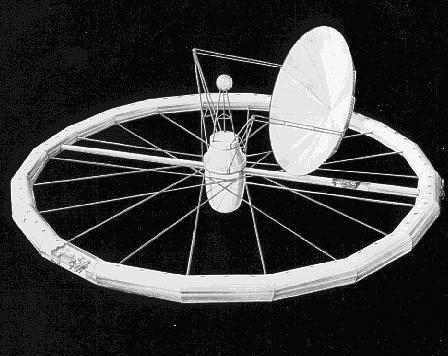
Food goes in, super dense dark-matter comes out.
Posted on 11/27/2004 1:52:08 PM PST by demlosers
That's what I thought too. LOL

Food goes in, super dense dark-matter comes out.
But it's another thing entirely to spin a space-suited astronaut on the end of pole in outer-space. That's not complex. It's not heavy. It's not expensive.Wheeeeeeeeeeeeeee!!!!!!!!It's just not indoors. The astronaut has to be suited, but we can give her 1 G of centrifugal force in outer-space.
Not to mention a) the impossibility of getting rockets that could push that mass out of Earth orbit; and b) the unfortunate tidal waves, earthquakes, and volcanoes that would result from a supermassive body moving around in low Earth orbit....
No way you'd want to have a non-rotating center -- that means all sorts of moving parts, bearings, seals, and so on.
Another major problem would be attitude control. How do you point the little guy when you need to do a burn?
Probably the biggest problem would be mass balancing. You'd have to be extremely careful about that, and it'd be very difficult to manage.
My bad. I meant a stable center of mass which would rotate. You should be able to do navigation and communication through that.
"Another major problem would be attitude control. How do you point the little guy when you need to do a burn?"
That's why I like cables. Stop the spin, reel in, lock the structure, then burn. Crews could meet, maybe exchange members to mix things up, trade baseball cards, whatever. Then unreel and re-rotate.
"Probably the biggest problem would be mass balancing."
True. Overboard dumps would have to be managed. But with two separate cables (one to each spacecraft), the center hub could "slide" one way or the other to remain a stable axis.
It is also helpful when the astronauts go to the restroom. Considering the most practical approach is the centrifuge idea, it is enough to make your head spin.
Actually, at a continuous acceleration of 1G, you can build up some quite amazing speeds really quickly.
For example, accelerating at 1G (9.81 meters/second) for a period of one day (86400 seconds) will give you a velocity of nearly 850 kilometers per second. During this time, you will travel over 36.5 million kilometers.
A two-day trip, therefore, accelerating until halfway, and decelerating thereafter, would take you more than 73 million kilometers from your starting point. A four-day trip would cover nearly 300 million kilometers, or more than the typical length of a trip to Mars.
Basically, using a continuous acceleration/deceleration of 1G will enable you to get to anywhere in the Solar System in less than a month.
Hint, for the observer, you were much too optimistic but for the passenger, the news is much better than you wrote.
It's Kubrick's fault. If it isn't Bush or Walmart, it's Kubrick.
In recent years, the idea has started to emerge that a short radius centrifuge contained within a spacecraft may be far more attractive. "You go into it for a workout. You get your G-tolerance buildup for a certain period of time, daily or a few times a week. That started to sound attractive to the engineers," Young said.
But wait a minute. There was a much smaller centrifuge inside the Discovery spaceship in 2001. Maybe it isn't Kubrick's fault after all.
For a movie that started production in 1964, 2001 is an amazing work.
Not completely. A denser than Earth substance would allow one to get closer to the gravitational center so that less mass would be required to obtain 1 g. As it happens if one could stand on the core of the Earth one would experience 1 g. (The massive core still being to much to launch.)
Read the fine print, dude...I didn't write "as much as the Earth weighs," I wrote "as much as a planet weighs." Even accounting for a high-density object permitting closer proximity, you'd still have at least a Mercury's worth of mass to lift off the ground.
What is your problem? Dude?
The bottom line is that the denser the mass, the less that is needed. BookaT mentioned the idea of a super dense mass. Such things are in our universe, just not on Earth in any quantity. If there were a way to assemble a mass of, say, concentrated neutrons as found in a neutron star, it would merit consideration. If there were a way.
My problem is a fellow who picks nits with others' statements, yet who expects those same others to accept his own technically erroneous statements without criticism.
If you see anyone like that, you let 'em know, okay?


So I was kind to say "not completely". Your statement above (post 7) is beyond "nit-picking", it confounds mass and weight, and g (acceleration at Earth surface) and G (gravitational constant), and it does not address BookaT's proposition.
Get a mirror.
[sigh]
Then lets do it.
Disclaimer: Opinions posted on Free Republic are those of the individual posters and do not necessarily represent the opinion of Free Republic or its management. All materials posted herein are protected by copyright law and the exemption for fair use of copyrighted works.